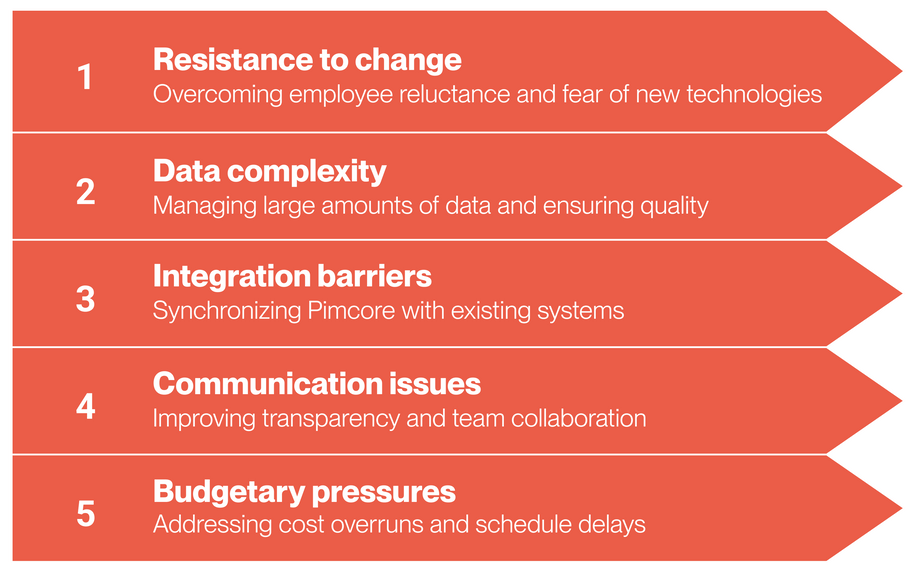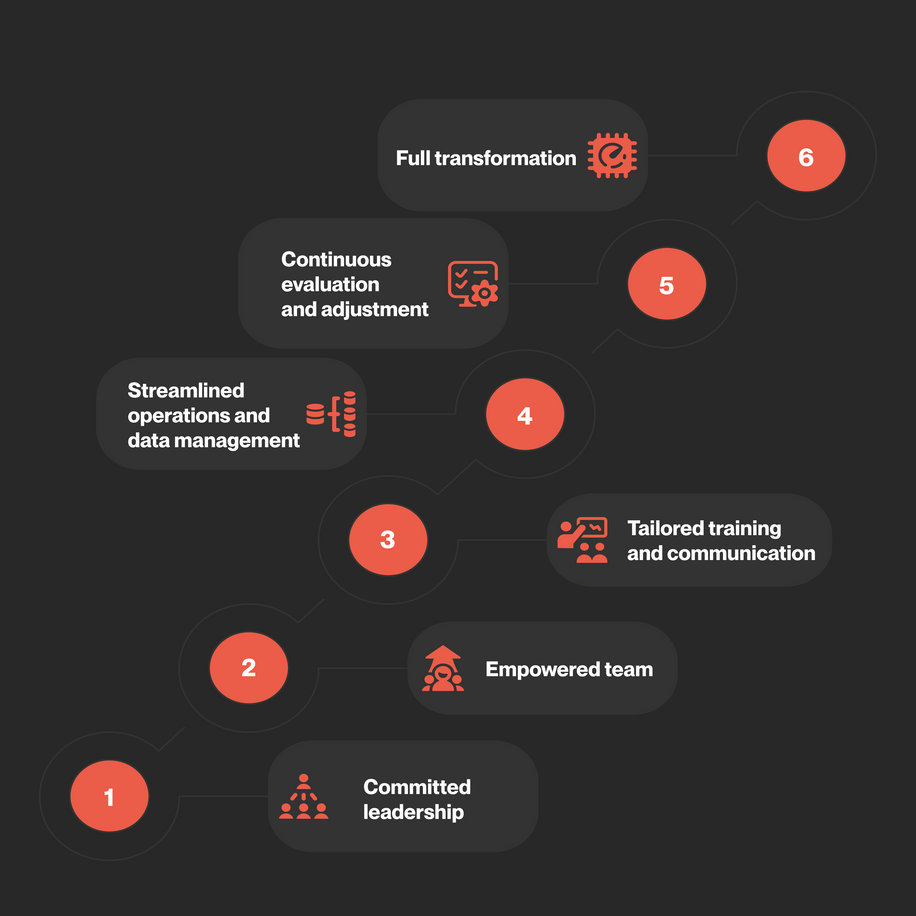How to make Pimcore generate the expected ROI: The importance of change management

In digital transformation, organizations often experience a familiar paradox. The promise of Pimcore – delivering increased revenue, improved operational efficiency, and better customer experiences – is usually compelling for executives. Yet, bringing these benefits to life often meets resistance, as employees worry about disrupting established routines and adapting to unfamiliar ways of working.
Technology forms the backbone of any transformation, but its success hinges on people, especially in complex deployments like Pimcore. When leaders concentrate solely on tools and neglect the experiences of end users, they open the door to resistance and poor system adoption, turning employee buy-in into the main challenge of PIM implementation.
This creates a misalignment between the strategic intent set by leadership and the operational realities faced on the ground. For decision-makers, this serves as a reminder that an investment in Pimcore technology by itself does not guarantee success. The full benefits of the investment are realized only when employees are fully prepared to embrace and proficiently use the system.
In this article, we examine how strategic change management is essential for realizing the full business value of Pimcore. While many organizations treat system installation as the final step, true success demands a shift in mindset, processes, and culture. By approaching PIM implementation as an organizational transformation – not just a technical project – companies can reduce risks, ensure adoption across teams, and fully unlock the platform's potential.
Why change management matters in PIM projects
Change management means having a clear process for handling any changes – whether adding something new, modifying existing elements, or removing parts – that might influence your organization or systems directly or indirectly. This includes steps like submitting requests, setting priorities, giving authorizations, approving changes, making plans, and finally carrying out the changes.
A clear distinction must be made between IT Change Management (ITCM) and Organizational Change Management (OCM).
ITCM targets system and infrastructure changes within the IT landscape, striving to minimize service interruptions, mitigate operational risks, and ensure regulatory compliance. OCM focuses on managing the people's side of change, encompassing the resolution of employee concerns, cultivating comprehension, and fostering workforce engagement.
Pimcore implementation is designed to bring positive transformation across the organization, streamlining processes for teams such as marketing, sales, IT, and product management. While it's reasonable to expect broad enthusiasm for such improvements, the reality is more complex. Despite the clear benefits, employee resistance can emerge (often rooted in uncertainty or disruption to established routines), and may jeopardize even the most technically sound implementations.
For this reason, a combined approach, where IT Change Management (ITCM) and Organizational Change Management (OCM) are developed and executed together, is not just beneficial but essential for the PIM project's success.
This creates a clear requirement for decision-makers: their Pimcore partner must be capable of aligning and managing both dimensions effectively. Too often, even those leading the initiative aren't fully convinced of the value of a comprehensive, well-structured implementation.
A partner focused only on technology might overlook organizational dynamics, while a partner focused solely on organizational issues may underestimate the technical complexity.
Success depends on a balanced, end-to-end approach: one that not only delivers the platform but also enables teams to work better with it.
Discover more about what the Pimcore system can do here.
Discover here how Pimcore and Akeneo compare and what distinguishes them.

Common Pimcore implementation challenges to prepare for
Below is a summary of key challenges typically faced when implementing Pimcore PIM, along with their organizational consequences:
| Challenge | Description | Organizational impact |
|---|---|---|
| Resistance to change | Fear of new technologies, job concerns, and lack of clarity on the system’s benefits* | Low adoption, workaround reliance (due to misalignment with actual user needs), ROI degradation, rising employee dissatisfaction |
| Data complexity and quality issues | Large amounts of data, inconsistencies, errors from manual processes, and cluttered assets | Product onboarding delays, inaccurate customer information, and compromised efficiency |
| Integration barriers | Difficulties in synchronizing Pimcore with current ERP, CRM, or e-commerce solutions | Fragmented data and inconsistent messaging across sales channels |
| Transparency and communication challenges | Teams operating in silos, insufficient sharing of data, tools, and aligned objectives | Reduced productivity, team confusion, communication lapses |
| Budgetary and scheduling pressures | Risks of cost overruns and schedule delays | Questionable ROI, increased stakeholder conflicts, and potential project abandonment |
*In many organizations, there's a strong bottom-up willingness to improve workflows: employees actively look for tools like PIM to simplify their tasks. The challenge arises when this initiative is overlooked or overridden by top-down decision-making, especially when led by a single product owner (PO) without deep consultation or involvement from operational teams.
Implementing Pimcore comes with a set of tightly linked challenges that often trigger a domino effect. Resistance to change from employees can delay the adoption of updated processes, making the already complex and frequently disorganized product data even harder to manage. In many organizations, misalignment or even conflict between teams further hinders progress, as each group may have different priorities or definitions of data ownership. Data quality issues, including duplicates, missing attributes, and inconsistencies, pose additional obstacles to integrating Pimcore with the current IT environment. Furthermore, limited cross-department communication and inadequate updates for stakeholders can result in confusion and misconceptions about both the scope and the intended goals of the project. Moreover, limited budgets and tight schedules add pressure, making it easy to misjudge how much work each project phase really requires.
That’s why a smart Pimcore implementation must see the bigger picture and handle these connected challenges together. Fixing data is just one part of the job. Processes and the way people think about data management need fixing, too. A complete change management approach, where technical tools go hand-in-hand with clear communication, proper training, and stakeholder involvement, is absolutely essential.

Strategic pillars for managing change in Pimcore projects
Overcoming the challenges of Pimcore implementation and ensuring project success requires anchoring your approach in a few vital pillars of change management.
Committed leaders with a clear vision
For a PIM transformation to succeed, leaders must first develop a thorough understanding of the technology and its business implications. This means actively participating in onboarding sessions, receiving dedicated training, and engaging with the implementation partner to build both technical and strategic awareness. Only then can they become effective advocates for change. With this foundation, leaders can communicate a clear vision, explain the purpose and benefits of the transformation, and lead by example. Establishing measurable goals and KPIs ensures accountability and helps track the organization’s progress throughout the PIM journey.
Empowering and engaging the team
Involving staff in decision-making builds accountability for transformation. While aligning everyone may not always be feasible, it’s crucial to actively listen to insights from frontline employees: those closest to the day-to-day operations. Middle managers act as a bridge between strategic goals and operational results.
Forming ambassador teams from multiple departments ensures comprehensive alignment. By clearly demonstrating how Pimcore enhances efficiency, streamlines processes, and develops new competencies, companies can maximize adoption and long-term success.
Tailored training and communication
Transparent and continuous communication helps lower resistance and keeps everyone prepared for change. Often, a lack of proper training fuels uncertainty.
A comprehensive communication plan, combined with role-appropriate training sessions, workshops, extensive learning materials (including guides, FAQs, and videos), and a system demo supports a smooth implementation.
Streamlining business operations and data management
Pimcore specializes in simplifying complex product data and improving business workflows.
A well-planned PIM strategy includes thorough data modeling to reflect product details accurately. All information should be gathered and managed within the PIM system for the best results. Consistent application of validation rules protects against data mistakes. Automation features should streamline data operations and approvals.
Constant evaluation and adjustment
Because digital transformation is an ongoing journey, dynamic monitoring is essential. It ensures that goals are on track, uncovers potential problems early, and highlights areas where further improvements can be made.
Key change management approaches for a successful Pimcore rollout are summarized in the table:
| Pillar of change management | Key actions | Benefits for PIM implementation | Addressed challenges from Table 1 |
|---|---|---|---|
| Committed leaders with a clear vision | Well-defined business objectives backed by C-suite leadership | Increased involvement, coherent strategy, and reduced pushback | Resistance to change, Transparency and communication challenges |
| Empowering and engaging the team | Involvement in decision-making, ambassador teams, emphasizing personal benefits | Faster adoption, sense of ownership, improved productivity | Resistance to change, Transparency and communication challenges |
| Tailored training and communication | Transparency, two-way communication, and individualized learning approaches | Reduced anxiety, enhanced skills, smoother adaptation | Resistance to change, Transparency and communication challenges |
| Streamlining business operations and data management | Building robust data models, automating workflows, and applying strong validation methods | Higher data quality, accelerated processes, error reduction, and greater operational efficiency | Data complexity and quality issues, Integration barriers, Budgetary and scheduling pressures |
| Constant evaluation and adjustment | Regular feedback cycles, implementation reviews, culture of improvement | Reduced exposure to risk, operational flexibility, constant improvement, and enduring success | Budgetary and scheduling pressures, Resistance to change |
From technical setup to full company transformation
We convert typical project risks into strategic benefits:
Integration barriers ☞ Fully integrated IT systems, accurate data flow, consistent omnichannel presence
Data complexity and quality issues ☞ High-quality data, efficient business processes, quicker product rollout
Budgetary and scheduling pressures ☞ Transparent project governance, financial control, on-schedule PIM deployment
Transparency and communication challenges ☞ Aligned information flow, broken silos, collaborative work environment. Because knowledge is the foundation of success.
Resistance to change ☞ Stronger adoption rates, motivated employees, frustration-free transitions
Clarity of roles and responsibilities
At Tandemite, we prioritize clear role allocation and transparent management from the outset. This ensures everyone understands their responsibilities, preventing departmental isolation, unnecessary expenses, and repeated data entry. By standardizing processes, we create a strong foundation for efficient and collaborative work.
Predictable, structured project execution
Tandemite’s structured project approach features detailed schedules, assigned resources, and transparent decision-making processes. This strategy minimizes risks and addresses concerns about implementation time.
Every stage, from development through testing to deployment, is carefully mapped out and resourced, providing full predictability and control over project delivery.
Continuous change oversight
Tandemite consistently applies a methodology based on continuous monitoring, regular feedback collection, and agile fine-tuning of upcoming implementation stages. Early identification of risks and immediate scope adjustments help to prevent project disruption and maintain order. The ongoing observation of change progress and commitment to process improvement are fundamental to this approach. Moreover, secure rollback scenarios are ready to be deployed if any obstacles occur.
Understanding IT and business
At Tandemite, we know that the success of digital projects lies in balancing technology with business aspirations. That’s why we implement Pimcore solutions in a way that directly supports key business priorities: higher sales, better customer service, and more efficient operations. With this approach, we avoid common problems like focusing too much on technology or having unclear goals, which often cause disappointment and a lack of involvement.
The Tandemite project team takes full responsibility for coordinating the entire transformation. By combining IT and business perspectives, we bring together people, processes, and technologies into a unified system that effectively supports strategic goal achievement. For decision-makers, this means less risk and a stable Pimcore PIM implementation. Instead of splitting responsibilities among different vendors or internal groups, they work with one partner who oversees the success of every stage – both technically and organizationally – ensuring long-term business value.



